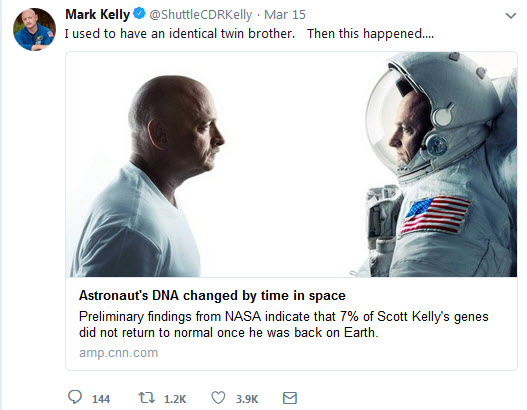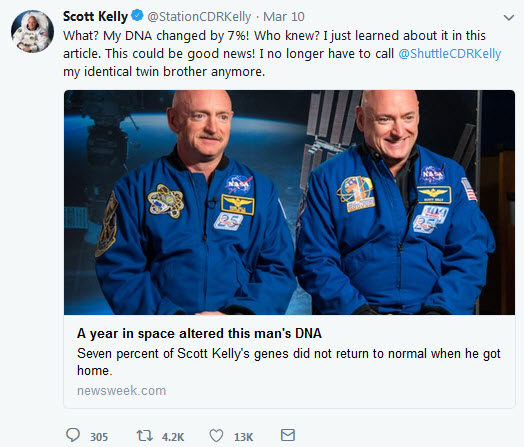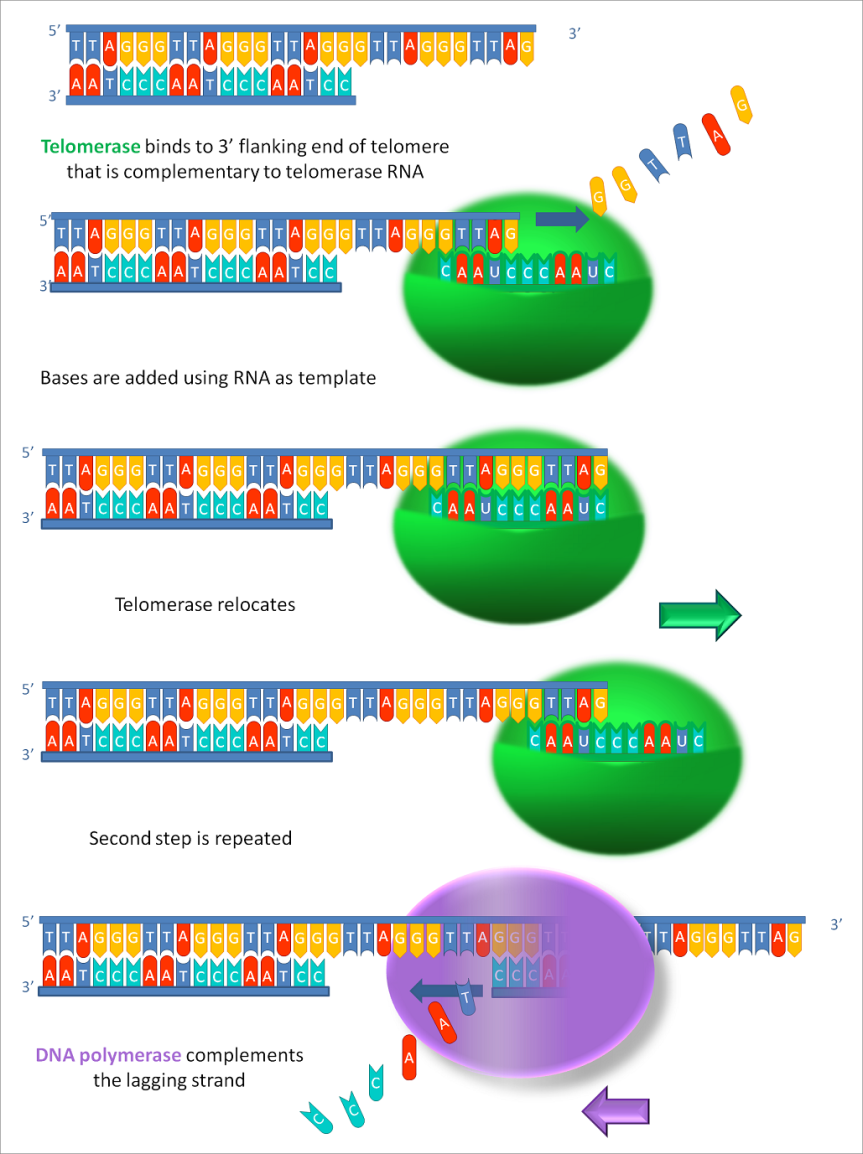In case the title threw you out of the loop, let me pull you back in. In 2015, NASA sent Scott Kelly to the International Space Station while his twin brother, Mark, stayed on the ground. When Scott came back, NASA ran a bunch of tests on them to see how space affects human body. Some of the findings were published a few weeks ago. Among the findings, one caught the eyes of media who ran stories like: Astronaut Scott Kelly now has different DNA to his identical twin brother after spending just a year in space (Daily Mail), Astronaut’s DNA no longer matches identical twin’s after time in space, NASA finds (Channel 3), Astronaut Scott Kelly’s genes show long-term changes after a year in space (NBC), Astronaut Scott Kelly is no longer an identical twin: How a year in space altered his DNA (Fox News), Scott Kelly Spent a Year in Space and Now His DNA Is Different From His Identical Twin’s (Time), Nasa astronaut twins Scott and Mark Kelly no longer genetically identical after space trip (Telegraph), Astronaut’s DNA changes after spending year in space when compared to identical twin bother (The Independent), Astronaut Scott Kelly’s DNA No Longer Matches Identical Twin’s After a Year in Space (People), NASA study: Astronaut’s DNA no longer identical to his identical twin’s after year in space (The Hill), NASA astronaut who spent a year in space now has different DNA from his twin (Yahoo News), Scott Kelly: NASA Twins Study Confirms Astronaut’s DNA Actually Changed in Space (Newsweek), If you go into space for a long time, you come back a genetically different person (Quartz), Space can change your DNA, we just learned (Salon), NASA Confirms Scott Kelly’s Genes Have Been Altered By Space Travel (Tech Times), even ScienceAlert 😦 ran Scott Kelly’s DNA Is No Longer Identical to His Twin’s After a Year in Space. And dozens and dozens more….
Even the astronauts themselves said their DNA is different and they are no longer twins:


Alas, dear Scott & Mark Kelly, rest assured that despite these titles and their afferent stories, you two share the same DNA, still & forever. You are still identical twins until one of you changes species. Because that is what 7% alteration in human DNA means: you’re not human anymore.
So what gives?
Here is the root of all this misunderstanding:
“Another interesting finding concerned what some call the “space gene”, which was alluded to in 2017. Researchers now know that 93% of Scott’s genes returned to normal after landing. However, the remaining 7% point to possible longer term changes in genes related to his immune system, DNA repair, bone formation networks, hypoxia, and hypercapnia” (excerpt from NASA’s press release on the Twin Study on Jan 31, 2018, see reference).
If I wouldn’t know any better I too would think that yes, the genes were the ones who have changed, such is NASA’s verbiage. As a matter of actual fact, it is the gene expression which changed. Remember that DNA makes RNA and RNA makes protein? That’s the central dogma of molecular biology. A sequence of DNA that codes for a protein is called a gene. Those sequences do not change. But when to make a protein, how much protein, in what way, where to make this protein, which subtly different kinds of protein to make (alternative splicing), when not to make that protein, etc. is called the expression of that gene. And any of these aspects of gene expression are controlled or influenced by a whole variety of factors, some of these factors being environmental and as drastic as going to space or as insignificant as going to bed.
Some more scientifically inclined writers understood that the word “expression” was conspicuously missing from the above-mentioned paragraph and either ran clarification titles like After A Year In Space, NASA Astronaut’s Gene Expression Has Changed. Possibly Forever. (Huffington Post) or up-front rebukes like No, space did not permanently alter 7 percent of Scott Kelly’s DNA (The Verge) or No, Scott Kelly’s Year in Space Didn’t Mutate His DNA (National Geographic).
Now, I’d love, LOVE, I tell you, to jump to the throat of the media on this one so I can smugly show how superior my meager blog is when it comes to accuracy. But, I have to admit, this time is NASA’s fault. Although it is not NASA’s job to teach the central dogma of molecular biology to the media, they are, nonetheless, responsible for their own press releases. In this case, Monica Edwards and Laurie Abadie from NASA Human Research Strategic Communications did a booboo, in the words of the Sit-Com character Sheldon Cooper. Luckily for these two employees, the editor Timothy Gushanas published this little treat yesterday, right at the top of the press release:
“Editor’s note: NASA issued the following statement updating this article on March 15, 2018:
Mark and Scott Kelly are still identical twins; Scott’s DNA did not fundamentally change. What researchers did observe are changes in gene expression, which is how your body reacts to your environment. This likely is within the range for humans under stress, such as mountain climbing or SCUBA diving.
The change related to only 7 percent of the gene expression that changed during spaceflight that had not returned to preflight after six months on Earth. This change of gene expression is very minimal. We are at the beginning of our understanding of how spaceflight affects the molecular level of the human body. NASA and the other researchers collaborating on these studies expect to announce more comprehensive results on the twins studies this summer.”
Good for you for rectifying your mistake, NASA! And good for you too the few media outlets that corrected their story like CNN who changed their title from Astronaut’s DNA no longer same as his identical twin, NASA finds to Astronaut’s gene expression no longer same as his identical twin, NASA finds.
But, seriously, NASA, what’s up with you guys keep screwing up molecular biology stuff?! Remember the arsenic-loving bacteria debacle? That paper is still not retracted and that press release is still up on your website! Ntz, ntz, for shame… NASA, you need better understanding of basic science and/or better #Scicomm in your press releases. Hiring? I’m offering!

REFERENCE: NASA. Edwards, M. & Abadie, L. (Jan. 31, 2018). NASA Twins Study Confirms Preliminary Findings, Ed. Timothy Gushanas, retrieved on March 14,15, & 16, 2018. Address: https://www.nasa.gov/feature/nasa-twins-study-confirms-preliminary-findings
By Neuronicus, 16 March 2018
P.S. Sometimes is a pain to be obsessed with accuracy (cue in smallest violins). For example, I cannot stop myself from adding something just to be scrupulously correct. Since the day they were conceived, identical twins’ DNAs are starting to diverge. There are all sorts of things that do change the actual sequence of DNA. DNA can be damaged by radiation (which you can get a lot of in space) or exposure to some chemicals. Other changes are simply due to random mutations. So no twins are exactly identical, but the changes are so minuscule, nowhere near 1%, let alone 7%, that it is safe to say that their DNA is identical.
P.P.S. With all this hullabaloo about the 7% DNA change everybody glossed over and even I forgot to mention the one finding that is truly weird: the elongation of telomeres for Scott, the one that was in space. Telomeres are interesting things, they are repetitive sequences of DNA (TTAGGG/AATCCC) at the end of the chromosomes that are repeated thousands of times. The telomere’s job is to protect the end of the chromosomes. You see, every time a cell divides the DNA copying machinery cannot copy the last bits of the chromosome (blame it on physics or chemistry, one of them things) and so some of it is lost. So evolution came up with a solution: telomeres, which are bits of unusable DNA that can be safely ignored and left behind. Or so we think at the moment. The length of telomeres has been implicated in some curious things, like cancer and life-span (immortality thoughts, anyone?). The most common finding is the shortening of telomeres associated with stress, but Scott’s were elongated, so that’s the first weird thing. I didn’t even know the telomeres can get elongated in living healthy adult humans. But wait, there is more: NASA said that “the majority of those telomeres shortened within two days of Scott’s return to Earth”. Now that is the second oddest thing! If I would be NASA that’s where I would put my money on, not on the gene expression patterns. And I would really, really like to see which types of cells show those longer telomeres, because I have a hunch is some type of dermal cell, which may be ontogenetically related to a neuronal cell.


